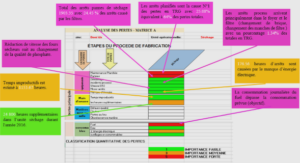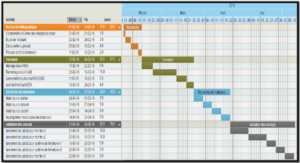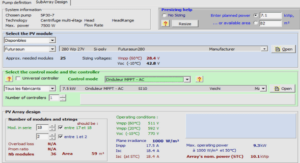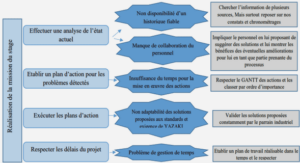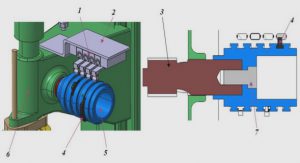Télécharger le fichier pdf d’un mémoire de fin d’études
Chemical effect
The chemical effect of NRP discharges is a subject often addressed in the literature. Most of the species produced by non-thermal plasmas in air present interesting properties, especially when considering combustion applications, on which the present work focuses. As mentioned in Section 1.2.1.1, application of NRP discharges in air results in the production of atomic oxygen from excited nitrogen quenching (see Equation (1.3)). Atomic oxygen can also result from direct electron-impact dissociation (see Cosby 1993; Laporta et al. 2014; Laporta et al. 2015): O2 + e− ! 2O+e−. (1.4) Atomic oxygen occupies a most significant position in the mechanism of hydrocarbon oxidation (described for instance in Law 2006), hence the interest of using NRP plasma discharges for combustion applications.
The generation of excited oxygen molecules, in particular the Singlet Delta Oxygen (SDO) molecule, O2 , from non-thermal plasma discharges has been investigated several times over the last decade (see Hicks et al. 2005; Ionin et al. 2007; Bowman et al. 2014) because of its potential in decreasing ignition delay times, as demonstrated by Popov (2011) in hydrogen-oxygen stoichiometric mixtures at atmospheric pressure and a range of temperatures from 300 to 1,000K. In this numerical study, addition of 1% of SDO molecules to ground-state molecular oxygen leads to a reduction in ignition delay time of the mixture of up to one order of magnitude. This effect is attributed to the role of SDO molecules in chain-initiation and chain-branching reactions: H2 +O2
In addition to this effect on ignition delay time, SDO molecules also proved their potential in increasing the laminar propagation velocity of flames. Indeed, Kozlov et al. (2008) have calculated an increase of up to 50% in the laminar flame speed of a lean hydrogen-air flame for 10% of SDO in the oxygen. In terms of hydrocarbon mixtures, an experimental study by Ombrello et al. (2010a) reports an increase of 5% in the laminar burning velocity of stoichiometric ethylene-air flames for an SDO content of 3,000 ppm in oxygen.
Ozone molecules are of interest to combustion applications because of their potential in enhancing the flame speed, as reported by Ombrello et al. (2010b), where an enhancement in the flame speed of lifted stoichiometric propane-air flames of up to 20% was observed for an addition of 5,000 ppm of ozone in the unburnt gas. Ozone production from non-thermal plasma has been validated with different types of discharges (see Kogelschatz et al. 1988; Chen and Davidson 2002; Mericam-Bourdet et al. 2012). The action of ozone in a combustion area is linked to the following three-body decomposition reaction: O3 +M ! O+O2 +M, (1.7) taking place in the pre-heat zone of a flame and leading to the production of atomic oxygen which, as mentioned above, contribute to the process of fuel oxidation. Ozone also reacts with atomic hydrogen during the fuel oxidation process to form hydroxyl radicals (OH). These radicals take part in the fuel oxidation process of hydrocarbon molecules as well. An experimental-numerical study by Singleton et al. (2016) investigates the effect of air humidity on the production of ozone by nanosecond plasma discharges in a lean (!=0.8) ethylene-air mixture at a pressure of 2 atm and a temperature of 473K. The experiments are in good agreement with simulations combining a one-dimensional detailed temporal evolution of the reduced electric field of the discharge and a zero-dimensional Boltzmann equation solver for each species of interest. Ozone density is measured by UV absorption with a UV LED and a photodiode detector equipped with a bandpass filter centred around 250 nm. The nanosecond spark discharges have a duration of 12 ns, a voltage amplitude of 40 kV and result in a deposition of energy per pulse of 50mJ.pulse−1. Figure 1.5 displays the experimental results of the temporal evolution of ozone density after a 12-ns discharge in a lean (!=0.8) ethylene-air mixture with various water contents.
Figure 1.5: Measured temporal evolution of ozone particle density in a lean (!=0.8) ethylene-air mixture at 2 atm and 473K. The streamer discharges have a duration of 12 ns, a voltage amplitude of 40 kV, and feature deposited energies of 50mJ.pulse−1. Taken from Singleton et al. (2016).
This experiment shows the potential of nanosecond plasma discharges in producing a high amount of ozone (in the order of 1015 cm−3). Figure 1.5 also highlights the role of humidity in the fresh gas mixture, which plays a significant role on the measured ozone density. This is due to the fact that, as atomic oxygen is produced by the NRP discharges, it recombines with water molecules into hydroxyl radicals: O+H2O ! 2OH, (1.8) rather than reacting with molecular oxygen, which would have resulted in ozone production by the following three-body reaction taking place at ambient temperature: O+O2 +M ! O3 +M. (1.9)
Additionally to these oxygen-related species, plasma discharges excite the nitrogen molecules in air (this is the origin of the violet light emission from plasma discharges in air, as seen in Figure 1.2). Because of their high concentration in air and their role in the production of atomic oxygen by the quenching reaction (1.3), excited nitrogen molecules are significant for the precise modelling of plasma discharges in air so that numerous studies focus on establishing the reaction rates for electron-impact excitation of nitrogen (see for instance Gillan et al. 1996; Vojnovic et al. 2015). The dissociation of nitrogen from plasma discharges can also lead to formation of nitric oxides, omnipresent molecules in today’s challenge regarding pollutants emission; thus the production of dissociated nitrogen is also a significant topic (see Kumar and Ghosh 1993).
Nitric oxides are a major concern because of their health hazards 1 and their role in the ozone layer depletion, in which nitric oxide reacts with the ozone in the stratosphere as follows: O3 + NO ! O2 + NO2. (1.10)
Emission of this chemical compound is one of the main issues in any combustion application involving air molecules. NO production from NRP discharges in the spark regime is investigated by Kim et al. (2006). The discharges have durations of 10 ns, voltage amplitudes of 5 kV and PRFs between 15 and 50 kHz.
Radial single point measurements are performed with a gas analyser placed 10mm above the nozzle of the burner for three different equivalence ratios of the methane-air mixture: !=0, 0.33 and 0.49. The results are displayed in Figure 1.6 and highlight the fact that the nanosecond plasma discharges in pure air can lead to concentrations in nitric oxides up to 120 ppm (see blue curve), i.e. higher concentrations than the lethal dose of 100 ppm.
Another work from Bak and Cappelli (2015) investigates the kinetics of NO formation in reactive mixtures at ambient conditions (p=1atm and T =300K).
This numerical study is divided in two parts: in the first, the products of NRP discharges with a duration of 10 ns, an amplitude of 5.3 kV and a PRF of 30 kHz are determined on the basis of a zero-dimensional model of a methane-air mixture (!=0.55). In the second part, the results of the first calculation are used as initial conditions for a one-dimensional combustion simulation of a premixed methane-air flame. Figure 1.7 displays the temporal evolution of several products of the NRP discharges for the zero-dimensional discharge computation at (i) constant volume and (ii) constant pressure conditions. The concentrations obtained at constant volume are higher than the ones at constant pressure but the former are only valid for times lower than the gas expansion time following the NRP spark discharge (of a few hundreds of nanoseconds, see Xu et al. 2014). Atomic oxygen and hydroxyl radicals reach concentrations of about 1017 cm−3 at constant pressure, while the concentrations in carbon monoxide 1the Center for Disease Control—CDC—sets the dose for the category Immediately Dangerous to Life or Health—IDLH—at a concentration of 100 ppm Figure 1.6: NO concentration along the radial direction at a height of 10mm above the nozzle of the burner for three different equivalence ratios of the methane-air mixture.
Study performed by Kim et al. (2006). and nitric oxide at the same condition of constant pressure are a bit lower (1 and 4⇥1016 cm−3).
Since pollutant emissions represent a major issue in the field of combustion, nitric oxide generation by NRP discharges is further addressed in Section 1.2.2.3 where the main applications of NRP plasma discharges to combustion are discussed.
NRP discharges for plasma-assisted combustion
In the past two decades, NRP discharges have been increasingly applied to combustion processes. Through numerical and experimental studies, the discharges have shown a potential for lowering the lean ignition limit for combustion, extending the stability domains of a flame, modifying the flame’s pollutants emission, controlling thermoacoustic pressure fluctuations. These effects are obtained with an input electrical energy of only a few percents of the thermal power of the flame. Some of these studies are presented in this section.
Plasma-assisted ignition
One common—and probably the most famous—instance of ignition per electrical discharge is the spark ignition in internal combustion (IC) engines where a spark plug produces a discharge in order to ignite a fuel-air mixture. The mech12 Figure 1.7: Temporal evolution of the products of NRP discharges in a methaneair (!=0.55) mixture for (i) constant volume and (ii) constant pressure conditions.
Taken from Bak and Cappelli (2015). anism leading to the ignition in the IC engine is mostly linked to the release of heat, though the fluid particles in the mixture are also chemically activated (generation of ions, radicals and excited fluid elements).
Recently, non-equilibrium plasma discharges have shown their potential for ignition of a wide range of sub- and supersonic combustible flows. A study from Pancheshnyi et al. (2006) demonstrates the efficiency of NRP plasma discharges as an igniter for propane-air mixtures from 0.35 to 2 bars. Figure 1.8 shows an example of ignition assisted by NRP plasma discharges: the propaneair mixture at an equivalence ratio of 0.7 is confined in a closed volume, where the initial pressure is 2 bars, and ignited by a train of ten NRP discharges of 1mJ energy each, pulsed at a PRF of 30 kHz between two electrodes separated by a distance of 1.5mm. The afterglow of the discharge is visible at 1.5ms; it is followed by the flame front propagation which is intensified by the shock wave produced by the plasma discharge, leading to hot spot formation 6ms after the discharge.
|
Table des matières
Introduction
1 Background
1.1 Introduction: plasma discharges
1.2 NRP plasma discharges
2 Effect of flow on NRP discharges
2.1 Introduction
2.2 Experimental setup
2.3 Results
2.4 Analysis and discussion
2.5 Conclusion
3 Effect of laminar premixed flames on NRP corona discharges
3.1 Introduction
3.2 NRP discharges parallel to flame front
3.3 NRP discharges perpendicular to flame front
3.4 Conclusion
4 Effect of NRP corona discharges on laminar premixed flames
4.1 Introduction
4.2 NRP discharges parallel to flame front
4.3 NRP discharges perpendicular to flame front
4.4 Numerical model for estimation of NRP discharges effect
4.5 Conclusion
5 Conclusion and outlook
5.1 Contributions of this thesis
5.2 Perspectives and future work
A Characterisation of NRP plasma discharges
B Hot wire calibration procedure
C Determination of reaction rate constants with BOLSIG+
D One-dimensional simulations of a stagnation flame and sensitivity analysis
E ModifiedGRI-Mech 3.0 for inclusion of ozone and nitric oxide effect
References
Télécharger le rapport complet

